During the evening of 6th November 1942 this 78 Squadron crew were tasked with a mine laying flight in the Nectarine region, this was an area to the north of the Frisian Islands. Sixty seven other aircraft across Bomber Command were to lay mines in a wide area from Lorient to the Frisian's on the same night. On board this aircraft was pretty much a scratch crew, four regular crew who had flown together were joined by three others. They took off from Linton on Ouse at 18.20hrs and dropped their mines in the area as instructed, they would have then turned for home but on the return leg they flew into cloud which saw them become unsure of where they were. They drifted slightly too far south and came in from the North Sea over the coast at around 2,500 feet but in the Hull area. This brought them close to the barrage balloons that protected the city and this then alerted the crew to their presence by a radio transmitter squeeker system that transmitted from the balloons and was picked up on the wirelesss equipment in the aircraft. The crew appears to have turned roughly north to avoid the balloons. They attempted to get assistance from a beam transmitted from Driffield airfield to assist crews in landing there but got no response. The wireless operator managed to receive signal informing the crew in the direction to head for Linton on Ouse and followed that course and still at a safe height in cloud. Ten minutes later wireless transmissions were heard by the crew of this aircraft and were between flying control at Linton on Ouse and another aircraft calling for landing instructions there. At the same time the aircraft was flying in the dashes of a Beam Approach System which indicated that they were on the right hand side of the airfield's runway. Whether or not this was the beam from Linton on Ouse is unclear. Hearing both the radio transmission from the aircraft landing and also the beam signal must have given the navigator a false indication of where they were so that he told the pilot it was safe to proceed to descend through cloud. While flying at around 140 miles per hour and at around 22.35hrs the aircraft then flew into high ground on Byland Moor, above Wass village on the southern edge of the North Yorkshire Moors. The incident is mentioned in a recently published book on the history of Wass which states that the aircraft ran up a hedge near Lund Farm before coming to rest in the corner of a field and and stopping in a clump of trees. As a result of the crash three of the crew were killed while four injured members of the crew were found trying to shelter at the crash site by local people who had come up to the site to help, they were taken down to the kitchen of Lund Farm, which at the time was lived in by the Kilvington family. These airmen were later collected and taken to York Military Hospital. The pilot was reasonable lucky, he escaped with minor injuries and would soon return to flying duties and completed his Tour. The bomb aimer was thrown out and into some trees nearby but in his fall he broke his leg and he suffered cuts to his face and hands, having spent some time in hospital he returned to flying duties in time to complete his first Tour when the pilot of DT525 did his final flight of his Tour and joined him on this flight. The wireless operator was seriously injured, he broke both his legs and a hand. He was dragged out of the burning wreckage by the flight engineer and he never flew again in the War returning to Canada when his legs had partly recovered. Their individual stories are recorded below.
One of the survivors gave an account of this incident to the Imperial War Museum in later years and he stated that the crash was caused by the known rudder over-balance problem with the early Halifax aircraft. This was a common problem with early Halifaxes but there is no mention of this being an issue or a cause of this aircraft to have crashed on any of the sources accident reports. He also believed that the pilot had possibly partly recovered control of the aircraft by the time it crashed. When the rudder over-balance problem occurred, normally the rudders locked to one side and it was usual for aircraft to fall out of the sky in an uncontrollable dive. I would dismiss this claim totally. Each survivor gave a statement shortly after the accident, these statements are given in the casualty file for the incident and no one mentioned rudder over-balance or control issues being a factor.
Halifax DT525 was built to contract B982938/39 by the English Electric Company Ltd at their Samlesbury factory near Preston. It was taken on charge as new by 78 Squadron at Linton on Ouse on 1st October 1942. Following the accident near Wass on 6th November 1942 the damage was assessed as being Cat.E2/FB(Burnt) damage and it was written off. It was struck off charge on 13th November 1942. By the date of the crash it had clocked up a total of just over twenty four hours flying time.
Those who lost their lives were :
Navigator - F/O Harry Lancaster Humphries RCAF (J/9527), aged 29, of Indian River, Ontario, Canada. Buried Newton on Ouse Churchyard, Yorkshire.
Mid Upper Gunner - Sgt Charles Frederick Clark RAFVR (1395017), aged 21, of Charlton, London. Buried Newton on Ouse Churchyard, Yorkshire.
Rear Gunner - F/Lt George Thomas Turner RAFVR (109520), aged 22, of Reading. Buried Henley Road Cemetery, Reading, Berkshire.
Those who survived were:
Pilot - Sgt Jacques George Mills RCAF (R/88215). Injured.
Flight Engineer - Sgt Robert Grey RAF (534199). Injured.
Wireless Operator / Air Gunner - Sgt Lloyd George Masterson RCAF (R/84399). Injured.
Bomb Aimer - Sgt Charles Murray Edghill RAFVR (1173753). Injured.


George Turner was born at the Custom House in West Ham, London on 19th August 1920 and was the eldest son of George Thomas Turner Senior and Lilian (nee Scurr) Turner. His family were evacuated to Reading during the war and those who survived settled there afterwards. The date he enlisted into the RAFVR is not yet known but prior to receiving a commission, to the rank of P/O on probation (emergency) on 11th October 1941, he was in the rank of F/Sgt with service number 746895. He was later promoted to F/O on 14th August 1942 but must have been in the rank of Acting F/Lt when he died in November 1942 as there is no reference in the London Gazette to him receiving the promotion to F/Lt under the terms of his commission. He married WAAF Irene Madge Warr in the Bulmer district of North Yorkshire in the latter part of 1942 (possibly at Newton on Ouse and in the weeks before his death). She was probably serving in the Linton on Ouse area at the same time but later served at Tempsford airfield. The photograph above shows them at their wedding. George Turner was the Squadron Gunnery Officer at the time of this accident at Wass and had volunteered to act as rear gunner for this flight. In the weeks before this incident he, Mills, Edghill and possibly some other members of the same crew listed above were involved in a flak incident but the details of it are not yet known. I thank Mr Ken Burgess, cousin of George Turner, for allowing the photograph and for additional information shown here. The photograph of his gravestone was found on an internet forum posted by "Clive".
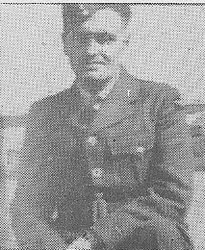
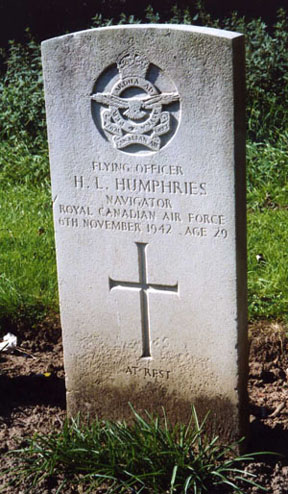
F/O Harry Humphries and his grave at Newton on Ouse, Harry Humphries was born on 20th April 1913 in Edmonton, Alberta, Canada and was the son of Joseph Allan and Margaret Helena (nee Lancaster) Humphries. His father died in 1933 and Harry was working as a teacher when he enlisted into the RCAF in Edmonton, Alberta on 14th March 1941. Having trained as an air observer in Canada he was awarded his observer Wings on 21st November 1941. He received a commission to the rank of P/O on 21st December 1941 and was later promoted to F/O on 1st October 1942. On arrival in the UK he trained at 9 (O)AFU beginning 20th March 1942, 16 OTU at Upper Heyford beginning 4th May 1942 and 29 OTU beginning 29th June 1942. He was initially posted to 425 Squadron on 18th August 1942 but this possibly never happened as he was then posted to 78 Squadron the following day. CWGC lists his "parents" James and Margaret Humphries as living in Indian River, Ontario, Canada on their database suggesting his mother had moved there by the time CWGC compiled their records.
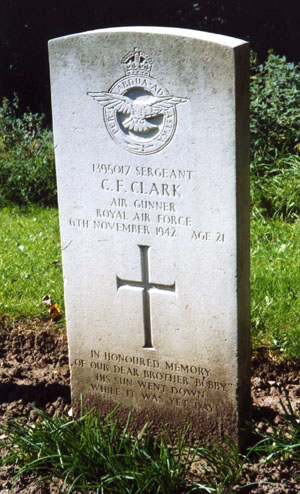

Charles Clark was born on 29th January 1921 in London and enlisted for RAF service on 18th August 1941. There is small memorial partly dedicated to those killed in the crash of Halifax DT525 inside the church but it is housed behind glass so is hard to photograph.

Lloyd Masterson was born on 1st May 1918 and enlisted for RCAF service on 28th January 1941. On 15th October 1942 he survived had the crash landing of 78 Squadron Halifax BB239 at Linton on Ouse airfield after the crew had turned back from an operational flight to bomb Cologne. The crew escaped injury but the aircraft was later deemed beyond repair and written off. Through contact with Sgt Lloyd Masterson's daughter I learn that the incident on Byland Moor occurred on his next operational flight, I thank her for the additional information and the photograph of her father she has kindly supplied to this account. He died in 2007.

Robert Grey was born on 13th June 1917 at Ashington and enlisted for RAF service on 25th August 1936. He received a commission on 19th January 1943 to the rank of P/O on probation (emergency). While in the rank of Acting F/Lt was sadly killed on 13th May 1943 when 78 Squadron Halifax JB924 was shot down by a night-fighter over Holland on Ops to Bochum. He is buried at Barradeel, Netherlands and was twenty five years old. At the time of his death he was the Squadron's Flight Engineer Officer. The photograph shown here of his grave was published to the internet by Frans Jeugdouderling.
Charles "Ray" Edghill was born in Port a Pierre, Trinidad on 27th August 1921 and his family were involved in the sugar industry. He moved to the UK in the early 1930s and initially went to school in Hove but later went to school in Brecon, Wales when his younger brother Ralph also came to the UK to attend school. He enlisted for RAF service on 20th July 1940 and originally begun training as a pilot but failed the initial training course so later re-mustered as an air observer. He was injured while training with 19 OTU at Kinloss while flying in Whitley N1498 which crashed near Tomatin, Inverness on 6th January 1942 killing a number of the crew and Sgt Edghill sustained serious injuries but recovered and completed his training. Much of what remained of N1498 was recovered by the Midland Aircraft Recovery Group in 2003. He then re-trained as a bomb aimer and briefly served with 76 Squadron but was posted to 78 Squadron before he flew any operational flights. His first pilot with 78 Squadron was Tait (but not the C.O.). He was seriously injured when Halifax DT525 crashed near Wass in November 1942 but eventually recovered and returned to operational flying in June 1943. On the night of 6th / 7th September 1943 he was flying in Halifax JD454 on Ops to Munich when the aircraft was shot down. He and one other escaped the aircraft but the remaining five airmen in the aircraft were killed. He saw the war out as a PoW. He gave an interview to the Imperial War Museum detailing his time in the RAF which is now available to listen to online. Charles Edghill died in 1998.
Jacques Mills was born on 9th June 1915 at Washington, USA and enlisted for RCAF service on 12th March 1941. He was living in either Montreal or Verdun, Canada when he enlisted into the RCAF in Halifax. Once in the UK he trained at 29 O.T.U. before posting to 78 Squadron. He later received a commission and completed his tour with 78 Squadron in 1943. For this service he was awarded the DFC, Gazetted on 10th September 1943 though he was not presented with it until November 1950 in Canada. Hugh Halliday's RCAF awards research has located the citation for his DFC which reads.."Flight Lieutenant Mills has always shown great determination and enthusiasm for his work and has pressed home his attacks against some of the most heavily defended European targets with the utmost zeal. As captain of aircraft he has shown fine qualities of leadership and a total disregard of danger." He later served as an instructor at 1652 HCU though nothing more of his service is known. Post-Ww2 he was awarded the French Croix de Guerre, the citation for this reads.. "This officer has taken part in more than 50 operational flights. He has, at all times, proved himself to possess great determination and, as commander of a section of four aircraft, he has set a fine example and achieved excellent results." He may have well flown a second Tour in the Middle East. He died at Minto, New Brunswick, Canada in 1987.
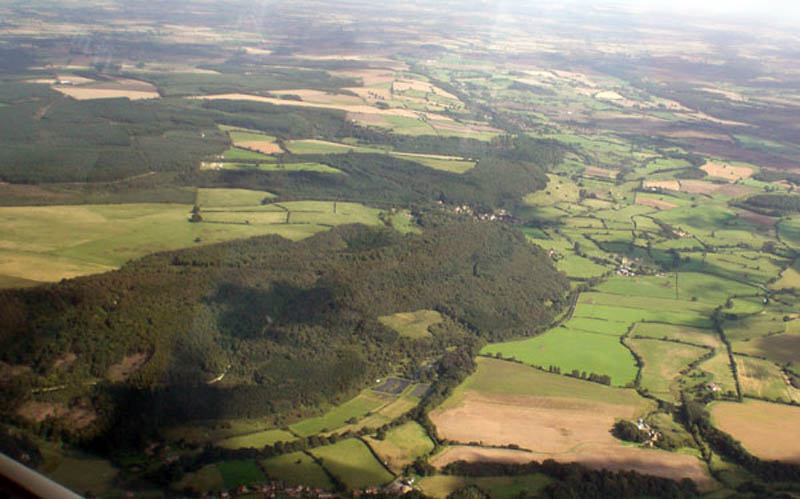
A photograph of the general Wass area which includes the crash site, this was taken from a glider over Sutton Bank by my brother.

Halifax DT525 flew into the ground close to the group of trees shown in the photograph shown above and the main bulk of the aircraft is reported as travelling into these trees. Over the years small fragments have been found within a twenty metre radius of the trees. I visited the site in June 2004 with guidance from air historian Eric Barton who had found small fragments in the area some years previous.
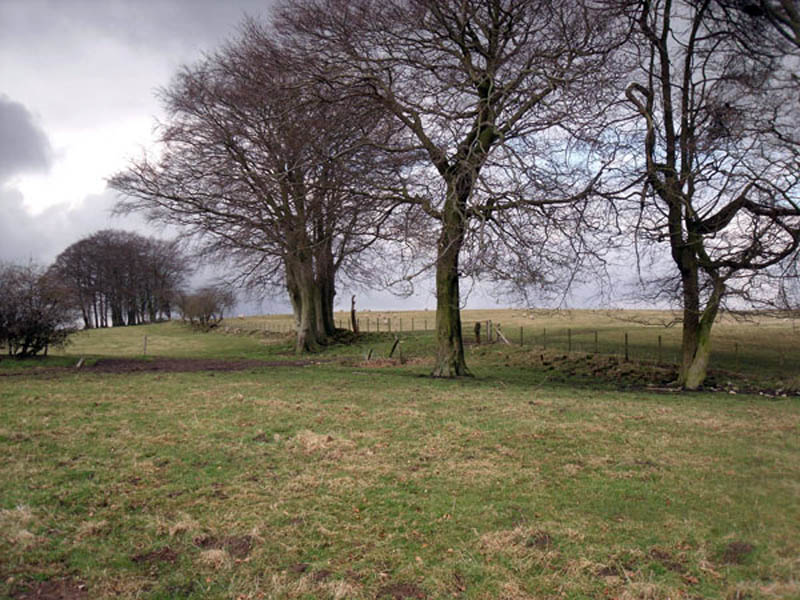
The general area of where the aircraft crashed.

These were the small fragments of the aircraft that were found on the surface and placed together in a tree root in 2004.